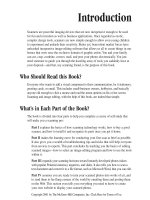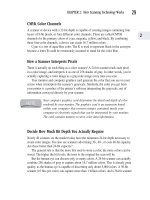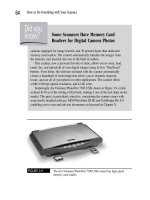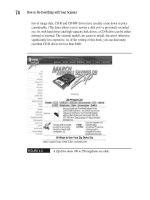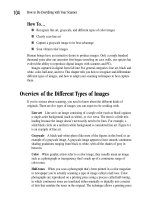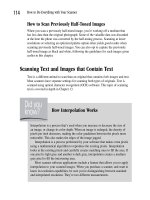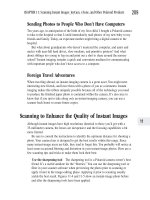How to do everything with PHP (phần 3) pot
Bạn đang xem bản rút gọn của tài liệu. Xem và tải ngay bản đầy đủ của tài liệu tại đây (919.08 KB, 50 trang )
84 How to Do Everything with PHP & MySQL CHAPTER 4: Using Conditional Statements and Loops 85
HowTo8 (8) / How to Do Everything with PHP & MySQL/Vaswani/225795-4/Chapter 4
84 How to Do Everything with PHP & MySQL CHAPTER 4: Using Conditional Statements and Loops 85
HowTo8 (8) / How to Do Everything with PHP & MySQL/Vaswani/225795-4/Chapter 4
Here, the if-elseif-else() control structure assigns a different value
to the $capital variable, depending on the country code. As soon as one of
the if() branches within the block is found to be true, PHP will execute the
corresponding code, skip the remaining if() statements in the block, and jump
immediately to the lines following the entire if-elseif-else() block.
Using the switch() Statement
An alternative to the if-else() family of control structures is PHP’s switch-
case() statement, which does almost the same thing. Here, a switch() statement
evaluates a conditional expression or decision variable; depending on the result
of the evaluation, an appropriate case() block is executed. If no matches can be
found, a default block is executed instead.
Here is what the syntax of this construct looks like:
<?php
switch (condition variable)
{
case possible result #1:
do this;
case possible result #2:
do this;
case possible result #n:
do this;
case default;
do this;
}
?>
Here’s a rewrite of the last example using switch-case():
<?php
switch ($country)
{
case 'UK':
$capital = 'London';
break;
case 'US':
$capital = 'Washington';
break;
ch04.indd 84 2/2/05 3:20:01 PM
TEAM LinG
84 How to Do Everything with PHP & MySQL CHAPTER 4: Using Conditional Statements and Loops 85
HowTo8 (8)
84 How to Do Everything with PHP & MySQL CHAPTER 4: Using Conditional Statements and Loops 85
HowTo8 (8)
case 'FR':
$capital = 'Paris';
break;
default:
$capital = 'Unknown';
break;
}
?>
A couple of important keywords are here: the break keyword is used to
break out of the switch() statement block and move immediately to the lines
following it, while the default keyword is used to execute a default set of
statements when the variable passed to switch() does not satisfy any of the
conditions listed within the block. Read more about the break keyword in the
section entitled “Controlling Loop Iteration with break and continue” later in
this chapter.
If you forget to break out of a case() block, PHP will continue executing
the code in each subsequent case() block until it reaches the end of the
switch() block.
The Ternary Operator
PHP’s ternary operator, represented by a question mark (?), is aptly named:
the first time you see it, you’re sure to wonder what exactly it’s for. The ternary
operator provides shortcut syntax for creating a single-statement if-else()
block. The following two code snippets, which are equivalent, illustrate how it
works:
<?php
if ($dialCount > 10)
{
$msg = 'Cannot connect after ↵
10 attempts';
}
else
{
$msg = 'Dialing ';
}
?>
<?php
$msg = $dialCount > 10 ? 'Cannot connect after ↵
10 attempts' : 'Dialing ';
?>
4
ch04.indd 85 2/2/05 3:20:01 PM
TEAM LinG
86 How to Do Everything with PHP & MySQL CHAPTER 4: Using Conditional Statements and Loops 87
HowTo8 (8) / How to Do Everything with PHP & MySQL/Vaswani/225795-4/Chapter 4
86 How to Do Everything with PHP & MySQL CHAPTER 4: Using Conditional Statements and Loops 87
HowTo8 (8) / How to Do Everything with PHP & MySQL/Vaswani/225795-4/Chapter 4
Nesting Conditional Statements
To handle multiple conditions, you can “nest” conditional statements inside each
other. For example, this is perfectly valid PHP code:
<?php
if ($country == 'India')
{
if ($state == 'Maharashtra')
{
if ($city == 'Bombay')
{
$home = true;
}
}
}
?>
However, a better idea (and also more elegant) is to use logical operators
wherever possible, instead of a series of nested conditional statements. This next
snippet illustrates by rewriting the previous example in terms of logical operators:
<?php
if ($country == 'India' && $state == 'Maharashtra' && $city == 'Bombay')
{
$home = true;
}
?>
Merging Forms and Their Result Pages
with Conditional Statements
Normally, when creating and processing forms in PHP, you would place the HTML
form in one file, and handle form processing through a separate PHP script. That’s
the way all the examples you’ve seen so far have worked. However, with the power
of conditional statements at your disposal, you can combine both pages into one.
To do this, assign a name to the form’s submit control, and then check whether
the special $_POST container variable contains that name when the script first
loads up. If it does, it means that the form has already been submitted, and you can
process the data. If it does not, it means that the user has not submitted the form
and you, therefore, need to generate the initial, unfilled form. Thus, by testing for
ch04.indd 86 2/2/05 3:20:01 PM
TEAM LinG
86 How to Do Everything with PHP & MySQL CHAPTER 4: Using Conditional Statements and Loops 87
HowTo8 (8)
86 How to Do Everything with PHP & MySQL CHAPTER 4: Using Conditional Statements and Loops 87
HowTo8 (8)
the presence or absence of this submit variable, you can use a single PHP script
to generate both the initial form and the postsubmission output.
To see how this technique works in the real world, consider the following
example:
<html>
<head></head>
<body>
<?php
// if the "submit" variable does not exist
// form has not been submitted
// display initial page
if (!$_POST['submit'])
{
?>
<form action="<?=$_SERVER['PHP_SELF']?>" method="post">
Enter a number: <input name="number" size="2">
<input type="submit" name="submit" value="Go">
</form>
<?php
}
else
{
// if the "submit" variable exists
// the form has been submitted
// look for and process form data
// display result
$number = $_POST['number'];
if ($number > 0)
{
echo 'You entered a positive number';
}
elseif ($number < 0)
{
echo 'You entered a negative number';
}
else
{
echo 'You entered 0';
}
}
?>
</body>
</html>
4
ch04.indd 87 2/2/05 3:20:02 PM
TEAM LinG
88 How to Do Everything with PHP & MySQL CHAPTER 4: Using Conditional Statements and Loops 89
HowTo8 (8) / How to Do Everything with PHP & MySQL/Vaswani/225795-4/Chapter 4
88 How to Do Everything with PHP & MySQL CHAPTER 4: Using Conditional Statements and Loops 89
HowTo8 (8) / How to Do Everything with PHP & MySQL/Vaswani/225795-4/Chapter 4
As you can see, the script contains two pages: the initial, empty form and the result
page generated after pressing the submit button. When the script is first called, it tests
for the presence of the $_POST['submit'] key. Because the form has not been
submitted, the key does not exist and so an empty form is displayed. Once the form has
been submitted, the same script is called again; this time, the $_POST['submit']
key will exist, and so PHP will process the form data and display the result.
The $_SERVER array is a special PHP array that holds the values of important
server variables: the server version number, the path to the currently executing
script, the server port and IP address, and the document root. For more on arrays,
see the section entitled “Using Arrays to Group Related Values,” in Chapter 5.
Repeating Actions with Loops
A loop is a control structure that enables you to repeat the same set of statements or
commands over and over again; the actual number of repetitions may be dependent on
a number you specify, or on the fulfillment of a certain condition or set of conditions.
Using the while() Loop
The first—and simplest—loop to learn in PHP is the so-called while() loop.
With this loop type, so long as the conditional expression specified evaluates to
true, the loop will continue to execute. When the condition becomes false, the loop
will be broken and the statements following it will be executed.
Here is the syntax of the while() loop:
<?php
while (condition is true)
{
do this;
}
?>
Taking a Shortcut
The <?=$variable?> syntax is a shortcut for quickly displaying the value of
a variable in a PHP script. It is equivalent to <?php echo $variable; ?>.
ch04.indd 88 2/2/05 3:20:02 PM
TEAM LinG
88 How to Do Everything with PHP & MySQL CHAPTER 4: Using Conditional Statements and Loops 89
HowTo8 (8)
88 How to Do Everything with PHP & MySQL CHAPTER 4: Using Conditional Statements and Loops 89
HowTo8 (8)
Here is a simple example that illustrates how a while() loop works by
creating a multiplication table for a specified number:
<?php
// define number and limits for multiplication tables
$num = 11;
$upperLimit = 10;
$lowerLimit = 1;
// loop and multiply to create table
while ($lowerLimit <= $upperLimit)
{
echo "$num x $lowerLimit = " . ($num * $lowerLimit);
$lowerLimit++;
}
?>
This script uses a while() loop to count forwards from 1 until the values of
$lowerLimit and $upperLimit are equal.
Using the do() Loop
A while() loop executes a set of statements while a specified condition is true.
If the condition evaluates as false on the first iteration of the loop, the loop will
never be executed. In the previous example, if the lower limit is set to a value
greater than the upper limit, the loop will not execute even once.
However, sometimes you might need to execute a set of statements at least
once, regardless of how the conditional expression evaluates. For such situations,
PHP offers the do-while() loop. The construction of the do-while() loop is
such that the statements within the loop are executed first, and the condition to be
tested is checked after. This implies that the statements within the loop block will
be executed at least once.
<?php
do
{
do this;
} while (condition is true)
?>
4
ch04.indd 89 2/2/05 3:20:02 PM
TEAM LinG
90 How to Do Everything with PHP & MySQL CHAPTER 4: Using Conditional Statements and Loops 91
HowTo8 (8) / How to Do Everything with PHP & MySQL/Vaswani/225795-4/Chapter 4
90 How to Do Everything with PHP & MySQL CHAPTER 4: Using Conditional Statements and Loops 91
HowTo8 (8) / How to Do Everything with PHP & MySQL/Vaswani/225795-4/Chapter 4
Thus, the construction of the do-while() loop is such that the statements
within the loop are executed first, and the condition to be tested is checked after.
Let’s now revise the previous PHP script so that it runs at least once, regardless
of how the conditional expression evaluates the first time:
<?php
// define number and limits for multiplication tables
$num = 11;
$upperLimit = 10;
$lowerLimit = 12;
// loop and multiply to create table
do
{
echo "$num x $lowerLimit = " . ($num * $lowerLimit);
$lowerLimit++;
} while ($lowerLimit <= $upperLimit)
?>
Using the for() Loop
Both the while() and do-while() loops continue to iterate for so long as
the specified conditional expression remains true. But there often arises a need to
execute a certain set of statements a fixed number of times, for example, printing
a series of ten sequential numbers, or displaying a particular set of values five times.
For such nails, the for() loop is the most appropriate hammer.
Here is what the for() loop looks like:
<?php
for (initialize counter; conditional test; update counter)
{
do this;
}
?>
PHP’s for() loop uses a counter that is initialized to a numeric value, and
keeps track of the number of times the loop is executed. Before each execution
of the loop, a conditional statement is tested. If it evaluates to true, the loop will
execute once more and the counter will be incremented by 1 (or more) positions.
If it evaluates to false, the loop will be broken and the lines following it will be
executed instead.
ch04.indd 90 2/2/05 3:20:02 PM
TEAM LinG
90 How to Do Everything with PHP & MySQL CHAPTER 4: Using Conditional Statements and Loops 91
HowTo8 (8)
90 How to Do Everything with PHP & MySQL CHAPTER 4: Using Conditional Statements and Loops 91
HowTo8 (8)
To see how this loop can be used, create the following script, which lists all the
numbers between 2 and 100:
<?php
for ($x = 2; $x <= 100; $x++)
{
echo "$x ";
}
?>
To perform this task, the script uses a for() loop with $x as the counter
variable, initializes it to 2, and specifies that the loop should run until the counter
hits 100. The auto-increment operator (discussed in Chapter 3) automatically
increments the counter by 1 every time the loop is executed. Within the loop, the
value of the counter is displayed each time the loop runs.
For a more realistic example of how a for() loop can save you coding time,
consider the following example, which accepts user input to construct an HTML
table using a double for() loop:
<html>
<head></head>
<body>
<?php
if (!$_POST['submit'])
{
?>
<form method="post" action="<?=$_SERVER['PHP_SELF']?>">
Enter number of rows ↵
<input name="rows" type="text" size="4"> ↵
and columns ↵
<input name="columns" type="text" size="4"> ↵
<input type="submit" name="submit" value="Draw Table">
</form>
<?php
}
else
{
?>
<table border="1" cellspacing="5" cellpadding="0">
<?php
4
ch04.indd 91 2/2/05 3:20:03 PM
TEAM LinG
92 How to Do Everything with PHP & MySQL CHAPTER 4: Using Conditional Statements and Loops 93
HowTo8 (8) / How to Do Everything with PHP & MySQL/Vaswani/225795-4/Chapter 4
92 How to Do Everything with PHP & MySQL CHAPTER 4: Using Conditional Statements and Loops 93
HowTo8 (8) / How to Do Everything with PHP & MySQL/Vaswani/225795-4/Chapter 4
// set variables from form input
$rows = $_POST['rows'];
$columns = $_POST['columns'];
// loop to create rows
for ($r = 1; $r <= $rows; $r++)
{
echo "<tr>";
// loop to create columns
for ($c = 1; $c <= $columns; $c++)
{
echo "<td> </td>\n";
}
echo "</tr>\n";
}
?>
</table>
<?php
}
?>
</body>
</html>
As you’ll see if you try coding the same thing by hand, PHP’s for() loop just
saved you a whole lot of work!
Controlling Loop Iteration with break and continue
The break keyword is used to exit a loop when it encounters an unexpected
situation. A good example of this is the dreaded “division by zero” error—when
dividing one number by another one (which keeps decreasing), it is advisable
to check the divisor and use the break statement to exit the loop as soon as it
becomes equal to zero. Here’s an example:
<?php
for ($x=-10; $x<=10; $x++)
{
if ($x == 0) { break; }
echo '100 / ' . $x . ' = ' . (100/$x);
}
?>
ch04.indd 92 2/2/05 3:20:03 PM
TEAM LinG
92 How to Do Everything with PHP & MySQL CHAPTER 4: Using Conditional Statements and Loops 93
HowTo8 (8)
92 How to Do Everything with PHP & MySQL CHAPTER 4: Using Conditional Statements and Loops 93
HowTo8 (8)
The continue keyword is used to skip a particular iteration of the loop and
move to the next iteration immediately. This statement can be used to make the
execution of the code within the loop block dependent on particular circumstances.
The following example demonstrates by printing a list of only those numbers
between 10 and 100 that are divisible by 12:
<?php
for ($x=10; $x<=100; $x++)
{
if (($x % 12) == 0)
{
echo "$x ";
}
else
{
continue;
}
}
?>
Summary
This chapter built on the basic constructs taught earlier to increase your knowledge
of PHP scripting and language constructs. In this chapter, you learned how to
use PHP’s comparison and logical operators to build conditional statements, and
use those conditional statements to control the flow of a PHP program. Because
conditional statements are also frequently used in loops, to perform a certain set
of actions while the condition remains true, this chapter discussed the loop types
available in PHP, together with examples of how and when to use them
If you’re interested in learning more about the topics in this chapter, these web
links have more information:
■ Control structures in PHP, at
.control-structures.php
■ The break and continue statements, at />control-structures.break.php and />control-structures.continue.php
4
ch04.indd 93 2/2/05 3:20:03 PM
TEAM LinG
Loops are frequently used in combination with one of PHP’s complex data
types: the array. Because that’s a whole topic in itself, I’m going to discuss it in
detail in the next chapter. And, once you know how it works, I’m going to show
you how arrays, loops, and forms all work together to make creating complex web
forms as easy as pie.
94 How to Do Everything with PHP & MySQL
ch04.indd 94 2/2/05 3:20:03 PM
TEAM LinG
Chapter 5
HowTo8 (8)
Using Arrays and
Custom Functions
ch05.indd 95 2/2/05 3:10:01 PM
Copyright © 2005 by The McGraw-Hill Companies. Click here for terms of use.
TEAM LinG
96 How to Do Everything with PHP & MySQL
HowTo8 (8) / How to Do Everything with PHP & MySQL/Vaswani/225795-4/Chapter 5
HowTo8 (8) / How to Do Everything with PHP & MySQL/Vaswani/225795-4/Chapter 5
N
ow that you know the basics of variables, operators, conditional statements,
and loops, and you can read and understand simple PHP scripts, it’s time to
move into murkier territory. As your familiarity with PHP increases, and your
scripts become more and more complex, you’ll soon find yourself wishing for
more sophisticated variables and data types. You’ll also wish for a way to simplify
common tasks, so as to reduce code duplication and make your scripts more efficient
and reusable.
How to…
■ Use a complex PHP data type—the array—to group and manipulate multiple
values at once
■ Create and access array values by number or name
■ Process the values in an array with the foreach() loop
■ Use arrays to group related form values
■ Split, combine, extract, remove, and add array elements with PHP’s built-in
functions
■ Define your own functions to create reusable code fragments
■ Pass arguments to your functions and accept return values
■ Understand the difference between global and local variables in a function
■ Store function definitions in a separate file and import them as needed
Using Arrays to Group Related Values
Thus far, the variables you’ve used contain only a single value—for example,
<?php
$i = 5;
?>
Often, however, this is not enough. Sometimes, what you need is a way to store
multiple related values in a single variable, and act on them together. With the
simple data types discussed thus far, the only way to do this is by creating a group
ch05.indd 96 2/2/05 3:10:02 PM
TEAM LinG
HowTo8 (8)
CHAPTER 5: Using Arrays and Custom Functions 97
HowTo8 (8)
of variables sharing similar nomenclature and acting on them together, or perhaps
by storing multiple values as a comma-separated string in a single string variable
and splitting the string into its constituents when required. Both these approaches
are inefficient, prone to errors and—most important to a programmer—lack elegance.
That’s where arrays come in. An array is a complex variable that enables
you to store multiple values in a single variable; it comes in handy when you
need to store and represent related information. An array variable can best be
thought of as a “container” variable, which can contain one or more values. Here
is an example:
<?php
// define an array
$flavors = array('strawberry', 'grape', ↵
'vanilla', 'caramel', 'chocolate');
?>
Here, $flavors is an array variable, which contains the values strawberry,
grape, vanilla, caramel, and chocolate.
The various elements of the array are accessed via an index number, with
the first element starting at zero. So, to access the value grape, use the notation
$flavors[1], while chocolate would be $flavors[4]—basically, the array
variable name followed by the index number in square braces.
PHP also enables you to replace indices with user-defined “keys” to create
a slightly different type of array. Each key is unique, and corresponds to a single
value within the array. Keys may be made up of any string of characters, including
control characters.
<?php
// define associative array
$fruits = array('red' => 'apple', 'yellow' => 'banana', ↵
'purple' => 'plum', 'green' => 'grape');
?>
In this case, $fruits is an array variable containing four key-value pairs.
The => symbol is used to indicate the association between a key and its value.
To access the value banana, use the notation $fruits['yellow'], while the
value grape would be accessible via the notation $fruits['green']. This
type of array is sometimes referred to as a hash or associative array.
5
ch05.indd 97 2/2/05 3:10:02 PM
TEAM LinG
98 How to Do Everything with PHP & MySQL
HowTo8 (8) / How to Do Everything with PHP & MySQL/Vaswani/225795-4/Chapter 5
HowTo8 (8) / How to Do Everything with PHP & MySQL/Vaswani/225795-4/Chapter 5
If you want to look inside an array, head straight for the print_r()
function, which X-rays the contents of any PHP variable or structure. Try
running it on any of the arrays in this tutorial, and you’ll see exactly what
I mean!
Creating an Array
To define an array variable, name it using standard PHP variable naming rules
and populate it with elements using the array() function, as illustrated in the
following:
<?php
// define an array
$flavors = array('strawberry', 'grape', ↵
'vanilla', 'caramel', 'chocolate');
?>
An alternative way to define an array is by specifying values for each element
using index notation, like this:
<?php
// define an array
$flavors[0] = 'strawberry';
$flavors[1] = 'grape';
$flavors[2] = 'vanilla';
$flavors[3] = 'caramel';
$flavors[4] = 'chocolate';
?>
True Colors
Remember the $_POST and $_GET container variables I introduced in the
section “Saving Form Input In Variables” in Chapter 3? If you go back and
look at them again, you’ll see that they’re associative arrays, with each form
variable and its input value represented as a key-value pair inside the array.
ch05.indd 98 2/2/05 3:10:03 PM
TEAM LinG
HowTo8 (8)
CHAPTER 5: Using Arrays and Custom Functions 99
HowTo8 (8)
To create an associative array, use keys instead of numeric indices:
<?php
// define an associative array
$fruits['red'] = 'apple';
$fruits['yellow'] = 'banana';
$fruits['purple'] = 'plum';
$fruits['green'] = 'grape';
?>
Modifying Array Elements
To add an element to an array, assign a value using the next available index
number or key:
<?php
// add an element to a numeric array
$flavors[5] = 'mango';
// if you don't know the next available index
// this will also work
$flavors[] = 'mango';
// add an element to an associative array
$fruits['pink'] = 'peach';
?>
To modify an element of an array, assign a new value to the corresponding
scalar variable. If you wanted to replace the flavor “strawberry” with “blueberry”
in the $flavors array created previously, you’d use the following:
<?php
// modify an array
$flavors[0] = 'blueberry';
?>
To remove an array element, use the array_pop() or array_push()
function, discussed in the section entitled “Using Array Functions.”
Some unique features of arrays are in the context of both loops and forms.
The following sections discuss these unique features in greater detail.
5
ch05.indd 99 2/2/05 3:10:03 PM
TEAM LinG
100 How to Do Everything with PHP & MySQL
HowTo8 (8) / How to Do Everything with PHP & MySQL/Vaswani/225795-4/Chapter 5
HowTo8 (8) / How to Do Everything with PHP & MySQL/Vaswani/225795-4/Chapter 5
Processing Arrays with Loops
To iteratively process the data in a PHP array, loop over it using any of the loop
constructs discussed in Chapter 4. To better understand this, create and run the
following script:
<html>
<head></head>
<body>
Today's shopping list:
<ul>
<?php
// define array
$shoppingList = array('eye of newt', ↵
'wing of bat', 'tail of frog');
// loop over it
// print array elements
for ($x = 0; $x < sizeof($shoppingList); $x++)
{
echo "<li>$shoppingList[$x]";
}
?>
</ul>
</body>
</html>
Here, the for() loop is used to iterate through the array, extract the elements
from it using index notation, and display them one after the other in an unordered list.
Note the sizeof() function used in the previous script. This function is
one of the most important and commonly used array functions, and it returns the
size of (number of elements within) the array. The sizeof() function is mostly
used in loop counters to ensure that the loop iterates as many times as there are
elements in the array.
The foreach() Loop
While on the topic of arrays and loops, it is worthwhile to spend a few minutes
discussing the new loop type introduced in PHP 4.0 for the purpose of iterating
over an array: the foreach() loop. This loop runs once for each element of
ch05.indd 100 2/2/05 3:10:03 PM
TEAM LinG
HowTo8 (8)
CHAPTER 5: Using Arrays and Custom Functions 101
HowTo8 (8)
the array, moving forward through the array on each iteration. On each run, the
statements within the curly braces are executed, and the currently selected array
element is made available through a temporary loop variable. Unlike a for()
loop, a foreach() loop doesn’t need a counter or a call to sizeof(); it keeps
track of its position in the array automatically.
To better understand how this works, rewrite the previous example using the
foreach() loop:
<html>
<head></head>
<body>
Today's shopping list:
<ul>
<?php
// define array
$shoppingList = array('eye of newt', 'wing of bat', ↵
'tail of frog');
// loop over it
foreach ($shoppingList as $item)
{
echo "<li>$item";
}
?>
</ul>
</body>
</html>
You can process an associative array with a foreach() loop as well,
although the manner in which the temporary variable is constructed is a little
different to accommodate the key-value pairs. Try the following script to see
how this works:
<html>
<head></head>
<body>
I can see:
<ul>
<?php
5
ch05.indd 101 2/2/05 3:10:03 PM
TEAM LinG
102 How to Do Everything with PHP & MySQL
HowTo8 (8) / How to Do Everything with PHP & MySQL/Vaswani/225795-4/Chapter 5
HowTo8 (8) / How to Do Everything with PHP & MySQL/Vaswani/225795-4/Chapter 5
// define associative array
$animals = array ('dog' => 'Tipsy', 'cat' => 'Tabitha', ↵
'parrot' => 'Polly');
// iterate over it
foreach ($animals as $key => $value)
{
echo "<li>a $key named $value";
}
?>
</ul>
</body>
</html>
Grouping Form Selections with Arrays
In addition to their obvious uses, arrays and loops also come in handy when
processing forms in PHP. For example, if you have a group of related checkboxes
or a multiselect list, you can use an array to capture all the selected form values in
a single variable for greater ease in processing. To see how this works, create and
run the following script:
<html>
<head></head>
<body>
<?php
// check if form has been submitted
if (!$_POST['submit'])
{
// if not, display form
?>
Select from the items below: <br />
<form action="<?=$_SERVER['PHP_SELF']?>" method="POST">
<select name="options[]" multiple>
<option value="power steering">Power steering</option>
<option value="rear wiper">Rear windshield wiper</option>
<option value="cd changer">6 CD changer</option>
<option value="fog lamps">Fog lamps</option>
<option value="central locking">Central locking</option>
<option value="onboard navigation"> ↵
ch05.indd 102 2/2/05 3:10:03 PM
TEAM LinG
HowTo8 (8)
CHAPTER 5: Using Arrays and Custom Functions 103
HowTo8 (8)
Computer-based navigation</option>
</select>
<input type="submit" name="submit" value="Select">
</form>
<?php
}
else
{
// form has been submitted
// check if any items were selected
// if so, display them
if (is_array($_POST['options']))
{
echo 'Here is your selection: <br />';
// use a foreach() loop to read and display array elements
foreach ($_POST['options'] as $o)
{
echo "<i>$o</i><br />";
}
}
else
{
echo 'Nothing selected';
}
}
?>
</body>
</html>
Notice in this script that the name of the <select> control contains the
square braces used when defining a PHP array. The result is this: when the form
is submitted, PHP will automatically create an array variable to hold the selected
items. This array can then be processed with a foreach() loop, and the selected
items retrieved from it.
You can do this with checkboxes also, simply by using array notation in
the checkbox’s name. For example, <input type=”checkbox”
name=”ingredients[]” value=”tomatoes”>.
5
ch05.indd 103 2/2/05 3:10:04 PM
TEAM LinG
104 How to Do Everything with PHP & MySQL
HowTo8 (8) / How to Do Everything with PHP & MySQL/Vaswani/225795-4/Chapter 5
HowTo8 (8) / How to Do Everything with PHP & MySQL/Vaswani/225795-4/Chapter 5
Using Array Functions
If you’re using an associative array, the array_keys() and array_values()
functions come in handy to get a list of all the keys and values within the array.
The following example illustrates this:
<?php
// define an array
$menu = array('breakfast' => 'bacon and eggs', ↵
'lunch' => 'roast beef', 'dinner' => 'lasagna');
// returns the array ('breakfast', 'lunch', 'dinner')
$result = array_keys($menu);
// returns the array ('bacon and eggs', 'roast beef', 'lasagna')
$result = array_values($menu);
?>
To check if a variable is an array, use the is_array() function, as in the
following:
<?php
// create array
$desserts = array('chocolate mousse', 'tiramisu');
// returns 1 (true)
echo is_array($desserts);
?>
You can convert array elements into regular PHP variables with the list()
and extract() functions. The list() function assigns array elements to
variables, as in the following example:
<?php
// define an array
$flavors = array('strawberry', 'grape', 'vanilla');
// extract values into variables
list ($flavor1, $flavor2, $flavor3) = $flavors;
// returns "strawberry"
echo $flavor1;
?>
ch05.indd 104 2/2/05 3:10:04 PM
TEAM LinG
HowTo8 (8)
CHAPTER 5: Using Arrays and Custom Functions 105
HowTo8 (8)
The extract() function iterates through a hash, converting the key-value
pairs into corresponding variable-value pairs. Here’s how:
<?php
// define associative array
$fruits = array('red' => 'apple', 'yellow' => 'banana', ↵
'purple' => 'plum', 'green' => 'grape');
// extract values into variables
extract ($fruits);
// returns "banana"
echo $yellow;
?>
You can add an element to the end of an existing array with the array_push()
function, and remove an element from the end with the interestingly named
array_pop() function. If you need to pop an element off the top of the array,
you can use the array_shift() function, while the array_unshift()
function takes care of adding elements to the beginning of the array. The following
example demonstrates all these functions:
<?php
// define array
$students = array('Tom', 'Jill', 'Harry');
// remove an element from the beginning
array_shift($students);
// remove an element from the end
array_pop($students);
// add an element to the end
array_push($students, 'John');
// add an element to the beginning
array_unshift($students, 'Ronald');
// array now looks like ('Ronald', 'Jill', 'John')
print_r($students);
?>
5
ch05.indd 105 2/2/05 3:10:04 PM
TEAM LinG
106 How to Do Everything with PHP & MySQL
HowTo8 (8) / How to Do Everything with PHP & MySQL/Vaswani/225795-4/Chapter 5
HowTo8 (8) / How to Do Everything with PHP & MySQL/Vaswani/225795-4/Chapter 5
The explode() function splits a string into smaller components on the
basis of a user-specified pattern, and then returns these elements as an array. This
function is particularly handy if you need to take a string containing a list of items
(for example, a comma-delimited list) and separate each element of the list for
further processing. Here’s an example:
<?php
// define string
$string = 'English Latin Greek Spanish';
// split on whitespace
$languages = explode(' ', $string);
// $languages now contains ('English', 'Latin', 'Greek', 'Spanish')
?>
Obviously, you can also do the reverse: the implode() function creates
a single string from all the elements of an array, joining them together with a user-
defined separator. Revising the previous example, you have the following:
<?php
// define string
$string = 'English Latin Greek Spanish';
// split on whitespace
$languages = explode(' ', $string);
// create new string
// returns "English and Latin and Greek and Spanish"
$newString = implode(" and ", $languages);
?>
Creating User-Defined Functions
A function is simply a set of program statements that perform a specific task,
and that can be called, or executed, from anywhere in your program. Every
programming language comes with its own functions, and typically also enables
developers to define their own. For example, if you had a series of numbers,
and you wanted to reduce each of them by 20 percent, you could pull out your
calculator and do it manually . . . or you could write a simple PHP function called
cheatTheTaxman(), send it the numbers one by one, and have it do the heavy
lifting for you.
ch05.indd 106 2/2/05 3:10:04 PM
TEAM LinG
HowTo8 (8)
CHAPTER 5: Using Arrays and Custom Functions 107
HowTo8 (8)
Functions are a Good Thing for three important reasons:
■ User-defined functions enable developers to extract commonly used
pieces of code into separate packages, thereby reducing unnecessary code
repetition and redundancies. This separation of code into independent
subsections also makes the code easier to understand and debug.
■ Because functions are defined once (but used many times), they are easy
to maintain. A change to the function code need only be implemented in
a single place—the function definition—with no changes needed anywhere
else. Contrast this with the nonabstracted approach, where implementing
a change means tracking down and manually changing every occurrence of
the earlier version of the code.
■ Because functions force developers to think in abstract terms (define input
and output values, set global and local scope, and turn specific tasks into
generic components), they encourage better software design and help in
creating extensible applications.
While PHP has always offered developers a well-thought-out framework
for basic software abstractions like functions and classes, PHP 5.0
improves this framework significantly with a redesigned object framework.
Read more about these improvements at />migration5.oop.php.
The following sections discuss how to create and use functions, arguments, and
return values in a PHP script.
Defining and Invoking Functions
To understand how custom functions work, examine the following script:
<?php
// define a function
function displayShakespeareQuote()
{
echo 'Some are born great, some achieve greatness, ↵
and some have greatness thrust upon them';
}
// invoke a function
displayShakespeareQuote();
?>
5
ch05.indd 107 2/2/05 3:10:05 PM
TEAM LinG
108 How to Do Everything with PHP & MySQL
HowTo8 (8) / How to Do Everything with PHP & MySQL/Vaswani/225795-4/Chapter 5
HowTo8 (8) / How to Do Everything with PHP & MySQL/Vaswani/225795-4/Chapter 5
In PHP, functions are defined using the special function keyword. This
keyword is followed by the name of the function (which must conform to the
standard naming rules for variables in PHP), a list of arguments (optional) in
parentheses, and the function code itself, enclosed in curly braces. This function
code can be any legal PHP code—it can contain loops, conditional statements,
or calls to other functions. In the previous example, the function is named
displayShakespeareQuote() and only contains a call to PHP’s echo()
function.
Calling a user-defined function is identical to calling a built-in PHP function
like sizeof() or die()—simply invoke it by using its name. If the function is
designed to accept input values, the values can be passed to it during invocation
in parentheses. In PHP 3.x, functions could only be invoked after they had been
defined. In PHP 4.x and PHP 5.0, functions can be invoked even if their definitions
appear further down in the program.
Using Arguments and Return Values
Because functions are supposed to be reusable code fragments (remember my
discussion at the beginning of this section about why they are Good Things?), it
doesn’t make sense for them to always return the same value. Thus, it is possible
to create functions that accept different values from the main program and operate
on those values to return different, more pertinent results on each invocation.
These values are called arguments, and they add a whole new level of power and
flexibility to your code.
Typically, you tell your function which arguments it can accept through an
argument list (one or more variables) in the function definition. When a function
is invoked with arguments, the variables in the argument list are replaced with the
actual values passed to the function and manipulated by the statements inside the
function block to obtain the desired result.
The Name Game
Function invocations are case-insensitive—PHP will find and execute the named
function even if the case of the function invocation doesn’t match that of the
definition—but to avoid confusion and add to the readability of your scripts,
a good idea is to invoke functions as they are defined.
ch05.indd 108 2/2/05 3:10:05 PM
TEAM LinG

